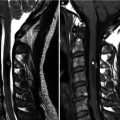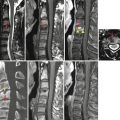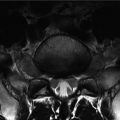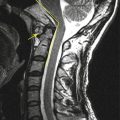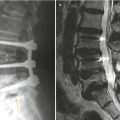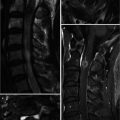, Joon Woo Lee1 and Jong Won Kwon2
(1)
Department of Radiology, Seoul National University Bundang Hospital, Seongnam, Kyonggi-do, Republic of Korea
(2)
Department of Radiology, Samsung Medical Center, Seoul, Republic of Korea
Abstract
In this chapter, we will describe radiologic findings suggestive of an unstable spinal injury. We also explain Denis’ three-column theory and the four major injury types of compression fractures, burst fractures, seat-belt-type injuries, and fracture–dislocations. We will present recently introduced classification systems for thoracolumbar and cervical injuries. In addition, differential features between benign osteoporotic and malignant compression fractures will be discussed. Tips to aid in identifying sacral insufficiency fractures will be also presented.
In this chapter, we will describe radiologic findings suggestive of an unstable spinal injury. We also explain Denis’ three-column theory and the four major injury types of compression fractures, burst fractures, seat-belt-type injuries, and fracture–dislocations. We will present recently introduced classification systems for thoracolumbar and cervical injuries. In addition, differential features between benign osteoporotic and malignant compression fractures will be discussed. Tips to aid in identifying sacral insufficiency fractures will be also presented.
4.1 Stable and Unstable Spinal Injuries
Daffner et al. reported five radiographic signs indicative of vertebral instability: displacement, widened interlaminar space, widened facet joint, disrupted posterior vertebral body line, and widened vertebral canal (Daffner et al. 1990).
Table 4.1
Five radiographic signs indicative of vertebral instability
Sign | Significance |
|---|---|
Displacement | Injury to major ligamentous and articular structures |
Widened interlaminar space | Injury to the posterior ligamentous structures and the facet joint |
Widened facet joint | Injury to the posterior ligamentous structures |
Disrupted posterior vertebral body line | Burst injury with disruption of the anterior bony and posterior ligamentous structures |
Widened vertebral canal (increase in the interpedicular distance of more than 2 mm) | Injury to the entire vertebra in the sagittal plane |
The three-column theory of Denis divides the spinal column into anterior (anterior half of the vertebral body), middle (posterior half of the vertebral body including its posterior wall), and posterior columns (posterior bony elements including the pedicles, lamina, facet joints, and spinous processes and the ligamentous structures including the ligamentum flavum, interspinous and supraspinous ligaments, as well as the facet joint capsule) (Denis 1983). When only one column is disrupted, the injury is considered mechanically stable. When two or more columns are disrupted, the injury is considered unstable (Denis 1983). The Thoracolumbar Injury Classification and Severity (TLICS) score has been described recently, focusing on clinical decision making by scoring of three major variables (Vaccaro et al. 2005). The three major variables are injury morphology (compression = 1, burst = 2, translation/rotation = 3, distraction = 4), integrity of the posterior ligamentous complex (intact = 0, suspected/indeterminate = 2, injured = 3), and neurologic status (intact = 0, nerve root injury = 2, complete cord injury = 2, incomplete cord injury = 3, cauda equina injury = 3). The injury severity score is obtained by summing up the scores of each major variable. A total score of more than 4 is an indication for surgery. More recently, the Sub-axial Cervical Spine Injury Classification (SLIC) scale has been described for the cervical spine (Vaccaro et al. 2007). In SLIC, the three major variables are injury morphology (compression = 1, burst = 2, distraction = 3, rotation/translation = 4), integrity of the disco-ligamentous complex (intact = 0, indeterminate = 1, disrupted = 2), and neurologic status (intact = 0, root injury = 1, complete cord injury = 2, incomplete cord injury = 3).
Table 4.2
Thoracolumbar Injury Classification and Severity (TLICS) scoring
Points | |
|---|---|
Morphology | |
Compression fracture | 1 |
Burst fracture | 2 |
Translational/rotational | 3 |
Distraction | 4 |
Neurology | |
Intact | 0 |
Nerve root | 2 |
Complete cord injury | 2 |
Incomplete cord injury | 3 |
Cauda equina injury | 3 |
Posterior ligamentous complex | |
Intact | 0 |
Injury suspected/indeterminate | 2 |
Injured | 3 |
Table 4.3
Sub-axial Cervical Spine Injury Classification (SLIC) scale
Points | |
|---|---|
Morphology | |
Compression fracture | 1 |
Burst fracture | 2 |
Distraction | 3 |
Translational/rotational | 4 |
Neurology | |
Intact | 0 |
Nerve root | 1 |
Complete cord injury | 2 |
Incomplete cord injury | 3 |
Continuous cord compression in setting of neuro deficit | +1 |
Disco-ligamentous complex | |
Intact | 0 |
Injury suspected/indeterminate | 1 |
Injured | 2 |
4.2 Major Thoracolumbar Injury: Denis Classification
Denis classified thoracolumbar trauma into four major injury types: compression fractures, burst fractures, seat-belt-type injuries, and fracture–dislocations (Denis 1983). A compression fracture is defined as anterior vertebral body collapse without posterior vertebral body wall involvement; this is indicative of anterior column failure by a compressive force without middle column failure. A burst fracture involves anterior and posterior vertebral body collapse with posterior vertebral body wall disruption resulting in retropulsion, reflecting anterior and middle column failure by a compressive force. A seat-belt-type injury represents failure of both the posterior and middle columns under tension forces generated by flexion and distraction, with preserved hinge function of the anterior column (if the anterior column loses this hinge function, it is classified as a fracture–dislocation flexion–distraction subtype injury). A seat-belt-type injury is also known as a Chance fracture in cases involving bony disruption. The seat-belt-type injury is also known as a flexion–distraction injury, a term more commonly used currently. A flexion–distraction injury is diagnosed if there is widening of the interspinous distance representing posterior ligamentous complex injury, along with horizontal fractures of the pedicles and articular processes. The accurate diagnosis of a flexion–distraction injury is important because it can be a cause of delayed neurologic deficits due to progressive kyphosis if left untreated. Gloves et al. described six criteria for a Chance-type flexion–distraction injury (Table 4.4) (Groves et al. 2005). Finally, the fracture–dislocation injury represents failure of all three columns leading to subluxation or dislocation. It can be also classified into three subtypes: flexion–rotation, shear, and flexion–distraction.
Table 4.4
Criteria for Chance-type flexion–distraction injury
1. Disruption of the posterior elements of the spine |
2. Longitudinal separation of the disrupted posterior elements |
3. Minimal or no decrease in the anterior vertical height of the vertebral body |
4. Minimal or no forward displacement of the superior vertebral fragment
Stay updated, free articles. Join our Telegram channel
Full access? Get Clinical Tree
 Get Clinical Tree app for offline access
Get Clinical Tree app for offline access

|
